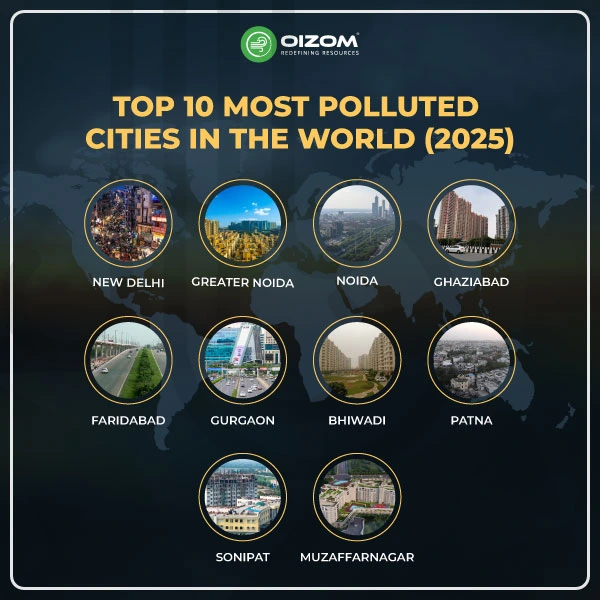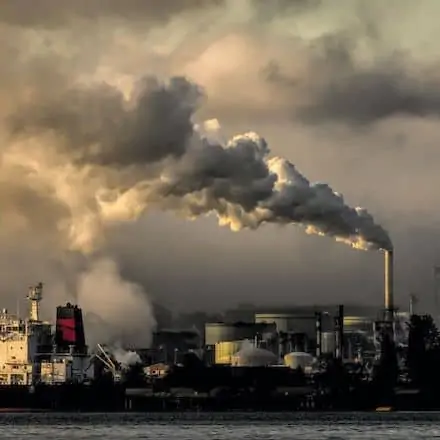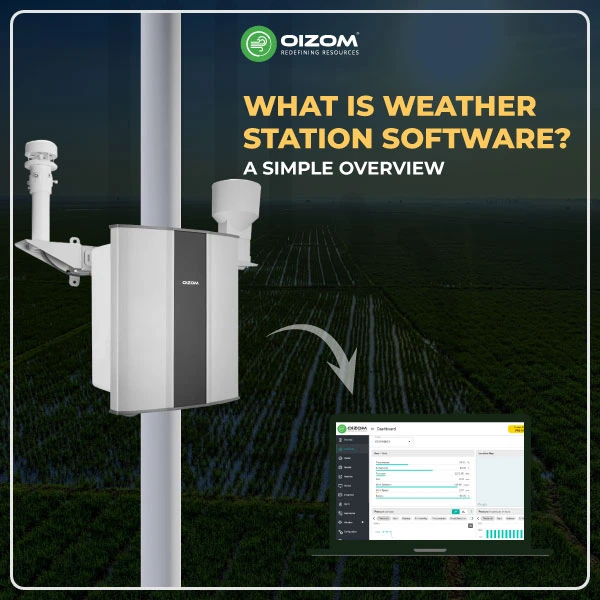Summary of Blog
Air pollution is the most severe environmental threat to public health globally, impacting our health, development, and environment. The top 10 most polluted cities in 2025 include Byrnihat, India; Delhi, India; Karaganda, Kazakhstan; and many others discussed in the blog. Air pollution’s health impacts include respiratory conditions, cardiovascular diseases, and lung cancer, while environmental impacts encompass acid rain, eutrophication, and climate change. Economically, it leads to increased medical costs and reduced productivity. The top 5 most polluted countries are Bangladesh, Pakistan, India, Bahrain and Nepal. Major causes of pollution include fossil fuel use, vehicular emissions, industrial activities, agriculture, and poor waste management. Efforts like the Paris Agreement aim to combat these issues. The blog underscores the urgent need for sustainable practices and cleaner technologies from companies like Oizom, which offers advanced air quality monitoring devices and provides real-time accurate data. However, if we practice or adopt sustainability towards a cleaner future, we will achieve SDG -3, 11, 13, and 15 for the urban environment.
Use of air quality monitoring stations:
Air quality monitoring refers to gathering and analyzing samples of ambient air pollution. To assess the condition of the air, data from these samples are compared to clean air standards, historical data on air quality levels, and data on its effects on human health and the environment. First, let us understand the monitoring needs:
Identifying the purpose behind the monitoring of air quality:
- Your monitoring requirements could include tracking indoor pollution levels in your home or workplace, determining the outdoor air quality for environmental projects, or adhering to industrial safety rules. Your options might be significantly reduced by defining your unique needs.
Which types of pollutants do you want to monitor:
- The EPA created National Ambient Air Quality Standards (NAAQS) for six common air pollutants, sometimes called “criteria” air pollutants, to safeguard human health and welfare across the country. The contaminants are particulate matter, ozone, carbon monoxide, sulfur dioxide, nitrogen dioxide, and lead.
Did you know Oizom has just launched its latest innovation in November 2024, Pollusense? It’s a portable air quality monitor designed to provide accurate, real-time data on pollutants and environmental conditions. Equipped with advanced sensor technology, Pollusense uses laser-based PID, MPS, and electrochemical sensors to detect particulate matter, gases like NO2, CH4, and VOCs. This compact portable device is perfect for industries, environmental audits, or anyone needing flexible air quality monitoring on the go. With this Pollusense, you get accurate insights wherever you are, ensuring you always stay informed.
Why does Pollusense truly stand out in the air quality monitoring space?
Because we don’t just build monitors; we build trust in data. Every Oizom air quality monitoring device is first calibrated in an ISO/IEC 17025:2017 certified lab using NIST-traceable gas standards, strictly following international guidelines (U.S. EPA Vol II, Section 6.0 Rev.1).
But we don’t stop there.
After lab calibration, each device goes through a second level of testing, collocation with a custom-built reference station equipped with U.S. EPA-designated Federal Equivalent Method (FEM) analyzers. This double-layered approach ensures that Pollusense delivers data you can depend on every single time.
The Top 10 Most Polluted Cities in the World:
It’s said that the air we breathe is the essence of life. However, for residents of the following cities, the air they breathe daily might be far from pure. Air pollution has become a primary global concern in the last few decades, leading to numerous health and environmental challenges. Here’s a look at the world’s top 10 most polluted cities and the pressing need for change. Below, I will discuss the most polluted cities in the world in 2025.
World’s Most Polluted Cities in 2024-25
According to the 2024 World Air Quality Report by IQAir, 91.3% of countries and regions failed to meet the WHO’s safe air quality standards for PM2.5 pollution. New Delhi is the capital of India and a part of the National Capital Territory of Delhi (NCT), has been named the most polluted city in the world, with an alarming AQI concentration of 169. Meanwhile, Delhi remains the world’s most polluted capital for the sixth year in a row, recording an annual PM2.5 level of 108.3 µg/m³. The report also highlights that 13 of the 20 most polluted cities worldwide are in India, emphasizing the urgent need for air quality improvements.
| Rank | City | Country | AQI in 2025 |
|---|---|---|---|
| 1 | New Delhi | India | 169 |
| 2 | Greater Noida | India | 166 |
| 3 | Noida | India | 161 |
| 4 | Ghaziabad | India | 159 |
| 5 | Faridabad | India | 154 |
| 6 | Gurgaon | India | 154 |
| 7 | Bhiwadi | India | 153 |
| 8 | Patna | India | 145 |
| 9 | Sonipat | India | 145 |
| 10 | Muzaffarnagar | India | 144 |
1.New Delhi, India
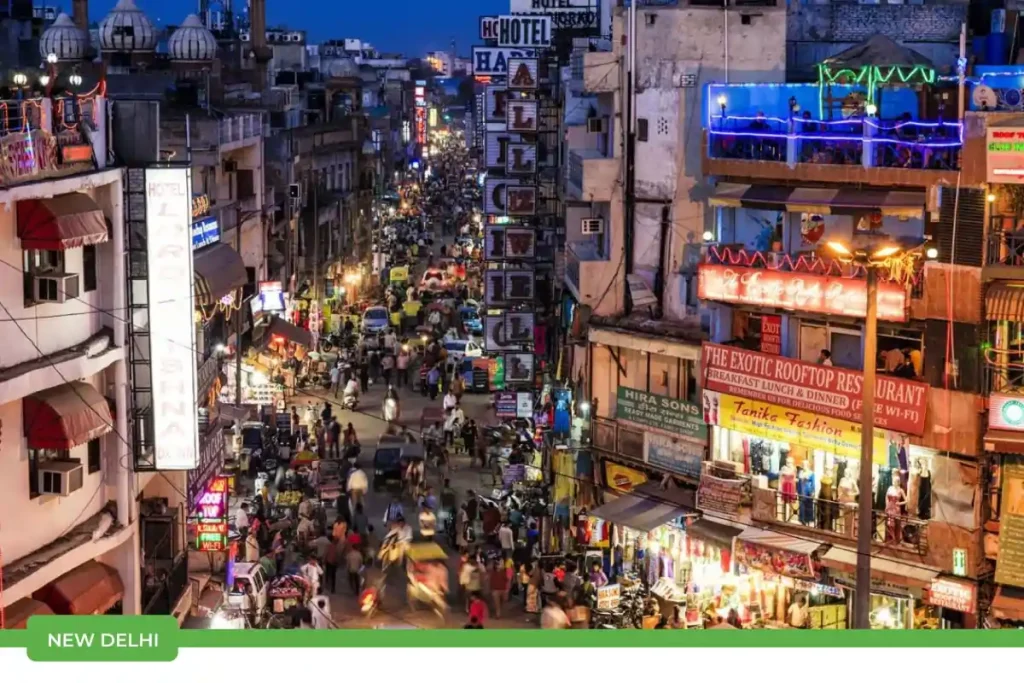
- City: New Delhi, India
- Average AQI (2025): 169
- AQI Category: Unhealthy
- Health Impact: Breathing the air is equivalent to smoking around two cigarettes a day
- Who’s at Risk: Children, the elderly, and those with respiratory conditions
- Key Concern: Toxic air remains a daily health hazard despite ongoing mitigation efforts.
- Urgency: Highlights the need for stricter enforcement, cleaner fuels, and sustainable urban planning.
2.Greater Noida, India
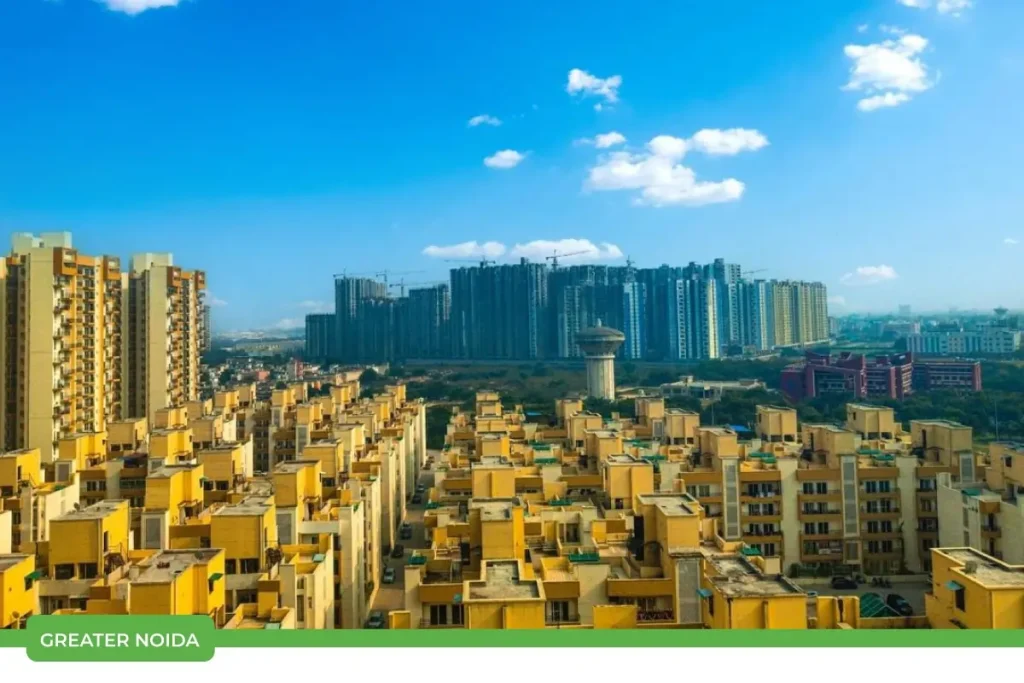
- City: Greater Noida, India
- Average AQI (2025): 166
- AQI Category: Unhealthy
- Health Impact: Breathing the air is like smoking two cigarettes a day
- Main Pollutants: PM2.5, PM10 from traffic, construction, and industries
- At-Risk Groups: Children, the elderly, and people with respiratory issues
- Impact: Common issues include coughing, eye irritation, and breathing discomfort
- Need for Action: Stricter dust control and better emissions management are essential.
3.Noida, India

- City: Noida, India
- Average AQI (2025): 161
- AQI Category: Unhealthy
- Health Impact: Breathing the air is like smoking two cigarettes a day
- Main Pollutants: PM2.5, PM10 from vehicles, construction dust, and local industries
- At-Risk Groups: Children, the elderly, and those with asthma or heart conditions
- Impact: Residents face frequent headaches, throat irritation, and poor visibility
- Need for Action: Better traffic control, cleaner fuels, and localized air monitoring are critical.
4.Ghaziabad, India

- City: Ghaziabad, India
- Average AQI (2025): 159
- AQI Category: Unhealthy
- Health Impact: Breathing the air is like smoking nearly two cigarettes a day
- Main Pollutants: PM2.5, PM10 from traffic congestion, industrial emissions, and construction dust
- At-Risk Groups: Children, seniors, and people with respiratory or heart issues
- Impact: Regular complaints of coughing, chest tightness, and eye irritation
- Need for Action: Targeted dust suppression, emission checks, and greener infrastructure are urgently needed.
5.Faridabad, India
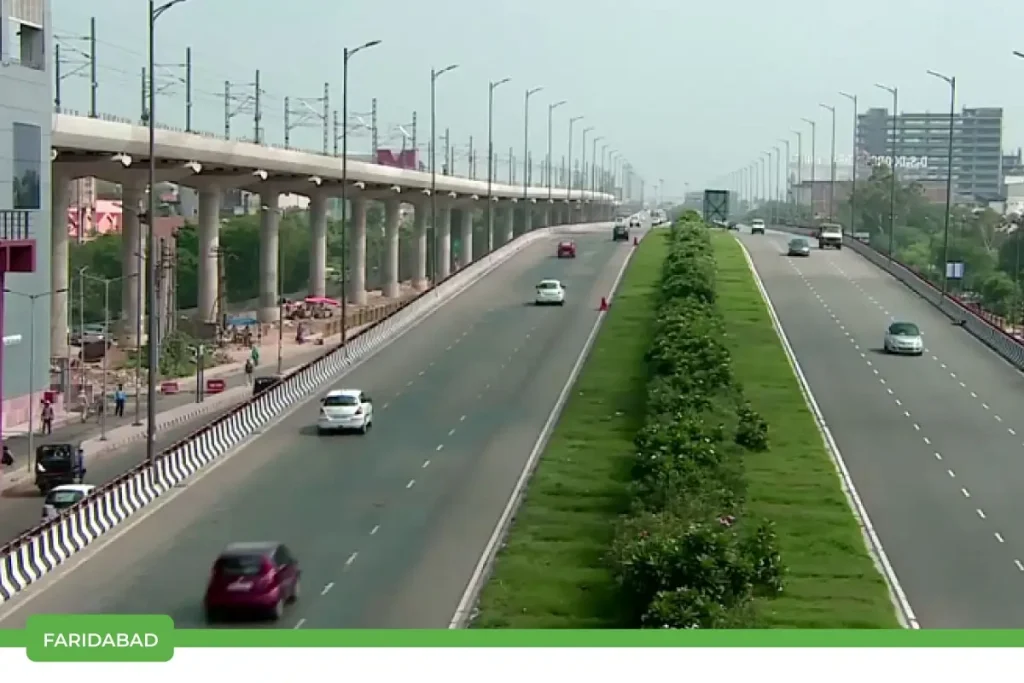
- City: Faridabad, India
- Average AQI (2025): 154
- AQI Category: Unhealthy
- Health Impact: Breathing the air is like smoking about two cigarettes a day
- Main Pollutants: PM2.5, PM10 from industrial zones, traffic, and dust
- At-Risk Groups: Children, the elderly, and those with lung or heart conditions
- Impact: Common issues include throat irritation, fatigue, and difficulty breathing
- Need for Action: Cleaner fuels, stricter emission control, and better waste management are key
6.Gurgaon, India

- City: Gurgaon, India
- Average AQI (2025): 154
- AQI Category: Unhealthy
- Health Impact: Breathing the air is like smoking about two cigarettes a day
- Main Pollutants: PM2.5, PM10 from vehicles, construction, and industrial activities
At-Risk Groups: Children, the elderly, and people with asthma or heart issues - Impact: Increased reports of headaches, coughing, and reduced outdoor activity
- Need for Action: Sustainable transport, dust control, and stricter pollution norms are urgently needed.
7.Bhiwadi, India
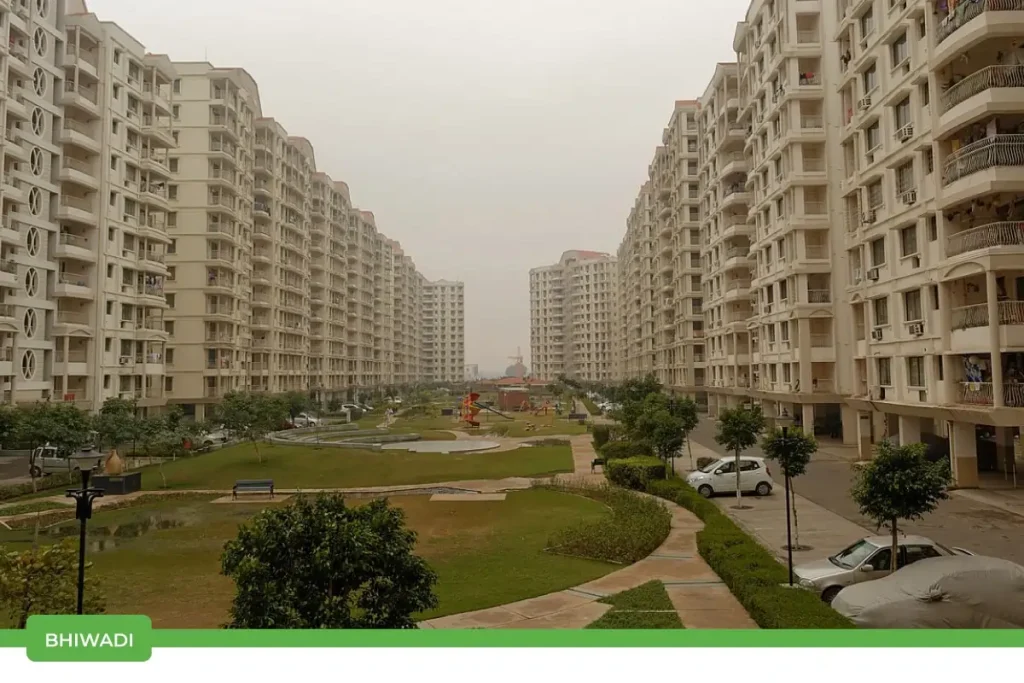
- City: Bhiwadi, India
- Average AQI (2025): 153
- AQI Category: Unhealthy
- Health Impact: Breathing the air is like smoking about two cigarettes a day
- Main Pollutants: PM2.5, PM10 from heavy industries, vehicular emissions, and dust
- At-Risk Groups: Factory workers, children, the elderly, and those with chronic illnesses
- Impact: Common issues include respiratory discomfort, eye irritation, and fatigue
- Need for Action: Industrial emission checks, green buffers, and real-time monitoring are essential.
8.Patna, India
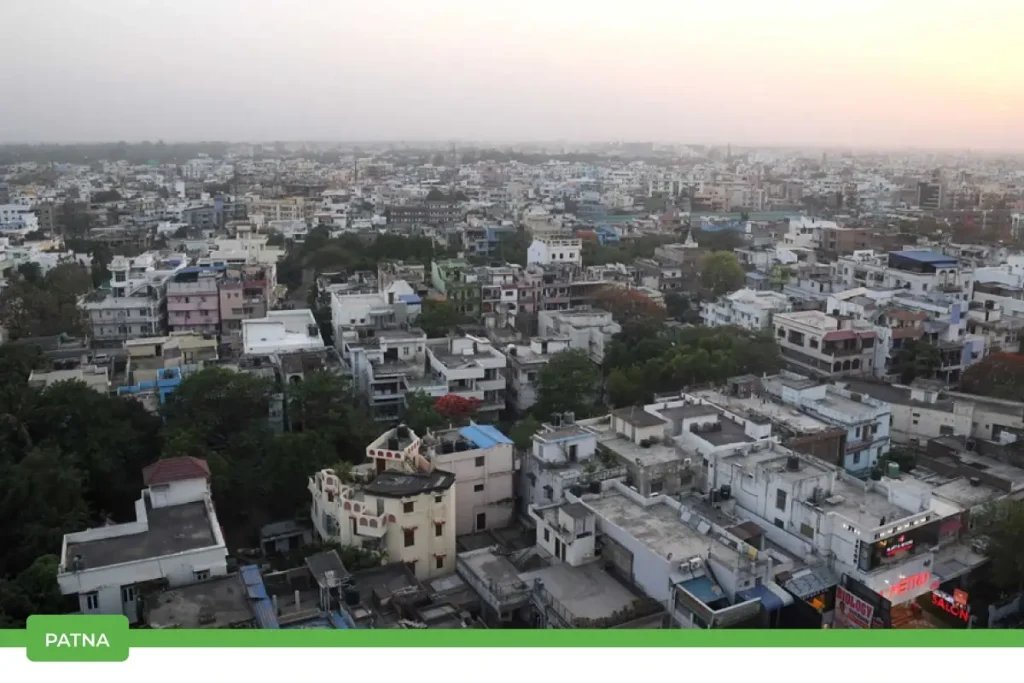
- City: Patna, India
- Average AQI (2025): 145
- AQI Category: Unhealthy for Sensitive Groups
- Health Impact: Breathing the air is like smoking over one cigarette a day
- Main Pollutants: PM2.5, PM10 from vehicle exhaust, open burning, and construction dust
- At-Risk Groups: Children, the elderly, pregnant women, and people with asthma or heart disease
- Impact: Mild breathing issues, eye irritation, and discomfort during outdoor activities
- Need for Action: Public awareness, clean fuel adoption, and better waste disposal practices are needed.
9.Sonipat, India
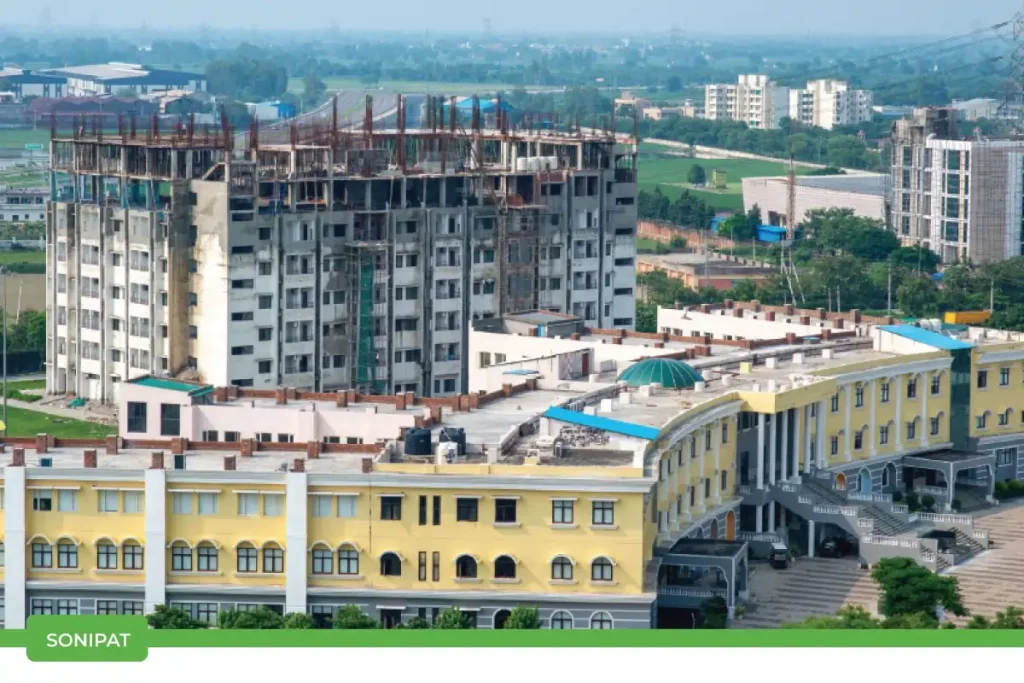
- City: Sonipat, India
- Average AQI (2025): 145
- AQI Category: Unhealthy for Sensitive Groups
- Health Impact: Breathing the air is like smoking over one cigarette a day
- Main Pollutants: PM2.5, PM10 from industrial activity, traffic, and dust
- At-Risk Groups: Children, the elderly, and individuals with respiratory or cardiac issues
- Impact: Increased chances of coughing, throat irritation, and reduced outdoor comfort
- Need for Action: Stronger industrial regulation, cleaner transport, and better air quality monitoring.
10.Muzaffarnagar, India

- City: Muzaffarnagar, India
- Average AQI (2025): 144
- AQI Category: Unhealthy for Sensitive Groups
- Health Impact: Breathing the air is like smoking about one cigarette a day
- Main Pollutants: PM2.5, PM10 from vehicular emissions, crop burning, and industrial units
- At-Risk Groups: Children, the elderly, and people with asthma or heart conditions
- Impact: Minor respiratory discomfort, eye irritation, and reduced outdoor air quality
- Need for Action: Effective crop residue management, regular industrial checks, and targeted awareness campaigns are essential.
Hey there! The data we’re analyzing was gathered in real-time on June 5th, 2025, through the real-time AQI. Additionally, the reference is also taken from the IQAir Report. It’s a snapshot of that specific day, which means the numbers can fluctuate daily. So, while this gives us a solid glimpse into the situation on that particular day, remember that tomorrow’s data might tell a slightly different story. Real-time data can be quite dynamic.
The cities mentioned above are among the most polluted in the world. Additionally, I will include information about the top 5 polluted countries globally.
- Bangladesh
- Pakistan
- India
- Bahrain
- Nepal
To wrap things up, this blog dives into the top 10 least polluted cities in India. I hope you find these insights helpful and interesting!
FAQs
New Delhi, India, ranks as the most polluted city in 2025 with an average AQI of 169, falling in the ‘Unhealthy’ category.
The top 10 include New Delhi, Greater Noida, Noida, Ghaziabad, Faridabad, Gurgaon, Bhiwadi, Patna, Sonipat, and Muzaffarnagar, all located in India.
High air pollution can cause breathing problems, heart disease, and lung cancer, and is especially dangerous for children and the elderly.
The major causes include vehicle emissions, industrial activity, construction dust, crop burning, and poor waste management.
Devices like Oizom’s Pollusense provide real-time, accurate air quality data, helping individuals and organizations take informed action to reduce exposure and improve health outcomes.

